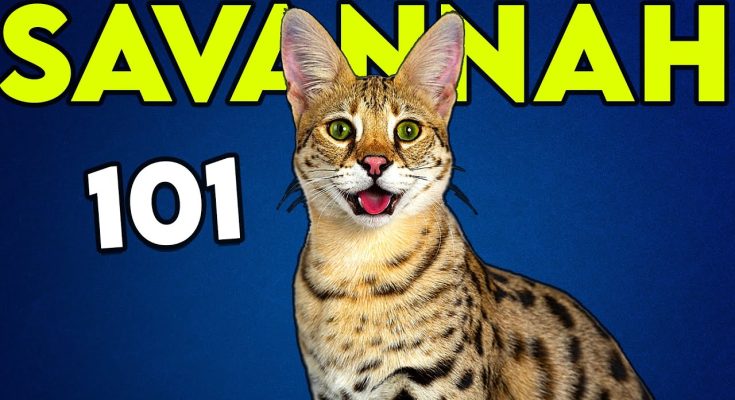SAVANNAH CAT 101: Must Watch Before Getting One | Cat Breeds
Oh, the gorgeous Savannah! This majestic breed is new, expensive, and highly popular! It’s larger than the average cat and can grow incredibly tall. Savannahs can proudly say they have a wild ancestor, the African Serval. Servals are medium-sized felines roaming the African savannahs! And now you know where Savannahs got their name from! Servals weigh from 18–40 lbs; while their weight may not be so impressive, their height and length surely are! They can be as long as 39 inches and as tall as 24 inches!
Even if not as handsome as other felines, their appeal comes from their gorgeous spotted coat, huge ears, and slender body. And if you’re still not impressed with their size, here’s a comparison between a household cat, a Serval…and your regular Joe! But how did Servals end up mating with cats? It’s a fascinating story, actually! In 1986, the first known Savannah cat was born – the offspring of a male Serval and a female Siamese-looking domestic cat.
The male Serval was intentionally brought up with the female cat. The gorgeous hybrid was named Savannah, after the Serval’s native habitat. The kitten inherited her father’s body type, large ears, spotted coat, facial expressions, body language, and wariness of strangers. Like her mother, she was talkative, active, and knew how to use the litter box.
Savannah was fertile, but she had trouble finding a suitor. It had nothing to do with Savannah’s looks but rather with the peculiar sounds she made, especially when in heat. Savannah made strange growls, trills, and other weird nondomestic noises that scared her suitors! After some time, Savannah’s owner came up with a great idea: to pair Savannah with a deaf cat! And here comes into the story Prince Albert, a deaf white Angora.
He was acquired by Savannah’s owner from a fellow breeder. The idea worked! Albert and Savannah quickly bonded and became lifelong companions. All it took was a deaf male to put up with an overly talkative female! Savannah and Albert had two litters together, but only 2 males and one female named Kitty survived.
The males were sterile, as is the case in most early generation hybrids. Sadly, after the two litters, Savannah and Albert stopped producing kittens. Moreover, Kitty was given to Prince Albert’s previous owner as a token for Albert. But the breeder that took Kitty retired and wasn’t interested in breeding her.
At this point, all seemed lost for Savannahs, but luckily, Patrick Kelly found an article about them! He had a thing for wild-looking domestic cats and managed to buy Kitty! Not only this, but he found Joyce Sroufe, an experienced cat breeder! Joyce Sroufe taught other breeders how to breed Savannahs. She was also the first one to breed down fertile males.
For her results, Joyce is regarded as the founder of the Savannah breed! But Savannahs still had a long way to go, as is the case with new breeds! Fortunately, Savannahs received their TICA championship status in 2012; even though they’re a new breed, they’re in high demand! And now, let’s talk about their unique looks! Savannahs are tall, lean, and graceful cats.
They’re gifted with relatively long legs, while their head is small in comparison to their bodies. Their face looks like a perfect triangle. Their ears are large, wide-based, and sit upright much like their ancestors’. Savannah’s inquisitive eyes are medium-sized and can be of any color, regardless of their coats.
But wait, what colors do they come in? Savannahs come in the following colors and patterns: black, black smoke, brown spotted, and black silver spotted. The only pattern allowed is spotted; however, in black Savannahs, the spots may not be visible. The gorgeous rosettes Bengals display are considered faults in Savannahs.
Still, some Savannahs have them, as Savannahs were crossed with Bengals in their early days. What about their size? Well, it can greatly vary and has to do with how close the Savannah is to the Serval. The first generation of Savannahs is called F1, the second one is called F2, and so on. To no one’s surprise, the biggest Savannahs are closest to the Serval, specifically F1 and F2 generations.
They’re the most expensive! How expensive, though? Probably pricier than you’d think, but I’ll discuss this topic later on. You should also know that not all Savannahs are considered “purebred” or Stud Book Traditional. Purebreds show at least three generations of Savannah-to-Savannah breeding on their pedigree.
The F4 generation is the earliest that can be purebred, but of course, not all of them are. Moving back to their size, let me give you an example to better understand the differences between generations. F1 Savannahs usually weigh between 19 and 22 pounds. At the same time, their height is about 16.
4 inches; F5 and lower Savannahs are similar in size to domestic shorthairs. Here is a comparison between a Serval, first generations of Savannahs, and a domestic shorthair. Also, size can vary considerably even between littermates due to Savannahs’ rich genetics. And now, let’s talk about their outstanding personalities! Savannahs are curious, alert, and highly active cats.
They love human companionship and adore receiving attention. They form strong bonds with their owners, always looking for their company and greeting them at the door. However, to receive their love, you must attend to their other need first -> lots and lots of playing. Savannahs are not only energetic, but they’re extremely intelligent! They need various games, such as feathered cat teasers, interactive toys, and a rich environment.
Savannahs are avid climbers, runners, and jumpers. You should definitely provide Savannahs with tons of climbing spaces, but that’s not all! You should also buy shelves and place them all around the room, so your Savannah could easily circle around the room from above. And don’t just feed your Savannah without asking your cat anything in return! Savannahs are gifted with a strong hunting instinct.
Make sure that instinct is fulfilled by making them “hunt” for their prey. As such, get them several food puzzles, or hide their food all around the house. Additionally, these cats quickly learn to play fetch by themselves and adore retrieving balls. Most of them don’t shy away from water! On the contrary, they love playing with it! Lots of Savannahs will relentlessly splash at their water bowl.
Some will even get into the shower with you! Others enjoy playing in a tub and even go for a swim! Basically, there are a ton of ways to have fun with them! Savannahs also love the outdoors, but it’s dangerous to leave them outside unsupervised. There are a ton of dangers they can encounter, and they pose a threat to wildlife.
But they can also be mistaken for wild felines. The great news? You can take them out on leash walks if you live in a quiet area. They’ll love it, and you’ll spend great quality time together. You can even build them a safe cat enclosure! If you meet their needs, you’ll have a loving, devoted, and happy Savannah.
These cats will follow you around tirelessly, watching everything you do and insisting on taking part in any activity. But make no mistake, it’s not easy to cater to their needs. You’ll need to be patient and spend lots of time with them. A bored Savannah will become mischievous and will resort to unwanted behavior to get your attention.
They’re skilled escaping artists, quickly learning to open doors. Make sure to securely close your door every time you get home, and beware of open windows. Savannahs don’t stop here, though -> they can and will get to the tallest places and figure out how to open cupboards and drawers in no time. How do Savannahs get along with children and other pets? Well, it depends on the generation.
In theory, Savannahs get along with both cats and dogs if they’ve been socialized early on. They also do fine with older, well-mannered children, while toddlers are not suited for Savannahs. But it’s essential to get your cat from a reputable breeder. The kittens have to be raised in a stable environment and preferably a busy household.
They need to receive plenty of affection and to be properly socialized. This is even more important in earlier generation Savannahs, as the Serval percentage is more significant in those cats. And even in the case of socialized cats, there can still be issues. Earlier generations tend to get scared easily.
While this isn’t an issue in itself, they can become aggressive when frightened. They’re also shy around strangers and should never be forced to interact with guests if they don’t feel like it. They can also be territorial, so it’s essential to be careful when choosing these generations, especially if you have other pets or kids.
For these reasons, don’t get Savannahs from back-yard breeders or unscrupulous people. Otherwise, you’ll likely end up with a problematic or antisocial big cat. Moving on, what other needs do they have? Besides the ones already mentioned, their diet should also be addressed. Some breeders recommend Savannahs to be on a partial raw diet, some recommend supplements.
Most breeders agree that Savannahs need more taurine than regular cats. As a result, consult the breeder regarding your Savannah’s diet and choose the best option for your cat. Furthermore, large Savannah cats require bigger homes and might play better with small dog toys. What are the health concerns associated with this breed? Even though it may be too soon to tell, Savannahs might be prone to developing HCM.
Before getting one, make sure to ask the breeder about their efforts to prevent this disease. The breeder should screen the cats to detect any anomalies and prevent affected cats from breeding. Also, ask the breeder about their efforts to prevent other major health issues. Furthermore, you should seek out a veterinarian that’s used to this breed, as some breeders say Savannahs are sensitive to ketamine anesthesia.
And now, the crucial question: How much do Savannahs cost? Before answering this question, I have to emphasize that Savannah ownership is sometimes restricted or forbidden, depending on where you live. An awesome site that can help you is hybridlaw.com, but it doesn’t cover all countries. So before you get too excited, make sure to learn about your local regulations.
But back to their price! First-generation Savannahs are the most expensive ones. To get one, you’ll have to pay between $17,000 and $22,000. Second generations Savannahs are cheaper, but you’ll still pay a lot of money, from $6,000 to $10,000. Lower generations can cost anywhere from $1,000 to $4,000. And there is a catch: when getting an earlier generation Savannah, you’ll most likely get a male, as they’re not fertile.
As always, don’t go for lower prices and look for accredited breeders. If you can’t afford a Savannah cat, just go to your local shelter and ask for the most active cat out there! You’ll be paying a lot less, and you’ll also save a cat’s life! I really hope you enjoyed this video. If you did, make sure to give it a like and subscribe! I have plenty of videos in which I talk about other cat breeds, and I’ll make more in the future.
Cr: https://www.youtube.com/watch?v=5zqXwoGKM-Y



